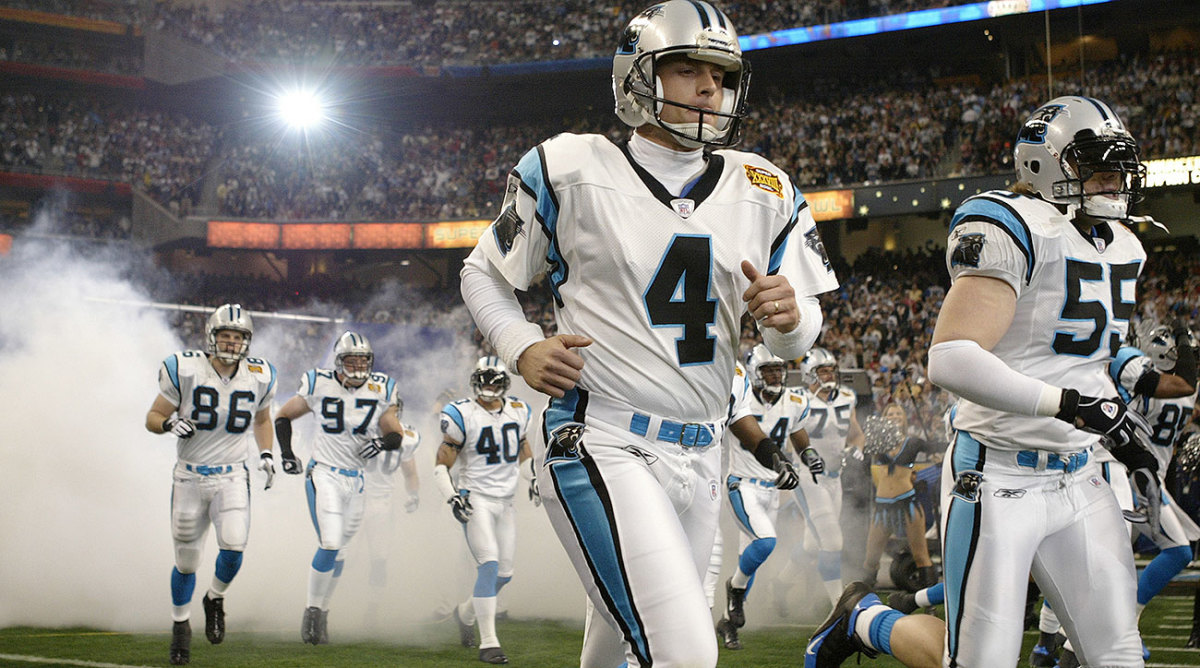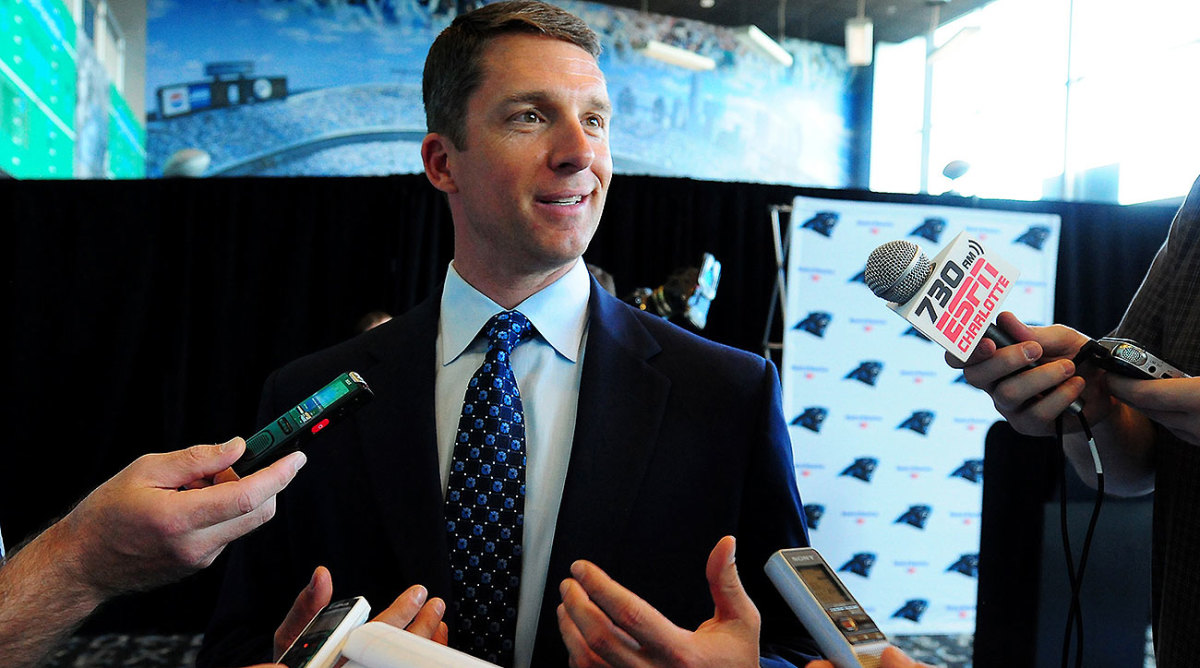John Kasay's fateful Super Bowl kickoff stays with him, but doesn't haunt him

There is not a single piece of memorabilia in John Kasay’s office that recalls his 21-year NFL career. There are plenty of mementos from his four children. A stapler with his name laminated on it. Schedules upon schedules for various teenage athletics teams.
But there are no game balls or plaques or framed jerseys in the office of the Charlotte Christian School athletic director. That’s the job Kasay has held for more than three years, overseeing the sports programs at Stephen Curry’s high school alma mater. Best known for his 16 years with the Panthers—and one fateful kickoff—Kasay doesn’t need to be surrounded by reminders of his first career now that he’s in his second, and about to be on his third.
“Football didn’t define me. That’s not who I am; that’s what I did,” Kasay says. “God has been very gracious and good to me. I’m a follower of Jesus Christ. I think there are a few more evidences of that. That’s how I define myself. I loved kicking. It was a great experience. I think football is a great sport and it helps a lot of people. It’s been great to my father, family, me, my children, but it’s never been what defines me.”
Perhaps it’s that mindset that has allowed Kasay to move on—but not forget—his kick out of bounds in the closing minutes of Super Bowl XXXVIII. He’s in the top-10 in NFL history in points scored, games played and field goals made, but Kasay has never been able to shake his moment of Super Bowl infamy.
“That’s the thing that always bothered me: It wasn’t that I kicked the ball out of bounds, it was the consequences of kicking the ball out of bounds,” Kasay said. “You put your defense in a bad situation. Those are the things that have always grated on me.
“My kids were talking about regrets and they asked me, ‘Dad, if you could go back and do one thing again, what would be the one thing that you’d go back and do?’ The first thing that came to my mind was, I would have kicked that ball right down the hash.”

The Panthers had made their first-ever Super Bowl in the 2003 season by going 11–5 and winning two playoff games on the road to face the Patriots in Houston. The game had it all. No fewer than four future Hall of Famers—Tom Brady, Julius Peppers, Adam Vinatieri and Steve Smith—shared the field. Janet Jackson had a wardrobe malfunction. A streaker halted play just before Kasay’s kickoff to start the second half. Two quarters of play saw no points, while the other two had them all.
With 1:08 left in the game, the Panthers tied the score at 29 when Jake Delhomme found Ricky Proehl for a 12-yard touchdown. Brady, with one Super Bowl to his name already two years after supplanting Drew Bledsoe as the starter, was not yet the Brady we know today. There was no guarantee that he could get the offense into field-goal range in a minute, and the game seemed likely to be the first Super Bowl to ever go to overtime.
Kasay, then 34, hadn’t booted a touchback all game long, so he wanted to pin the ensuing kickoff near the right sideline and make things difficult for Patriots return man Bethel Johnson. In that situation, a left-footed kicker can aim to that spot and kick it straight, or he can aim straight and put some left-to-right English on the ball. Kasay combined the worst of both strategies.
He knew it as soon as he kicked it. The ball shot right off the tee and hooked out of bounds at the 18-yard line, giving the Patriots the ball at the 40 with more than a minute of game clock (and all three timeouts) to get into Vinatieri’s range. Five plays later, Vinatieri hit the game-winning 41-yard field goal with nine seconds left.
• SI VAULT (2004): Tom Brady keeps his cool, leads Patriots to second title in three years
“If there’s one question I get from every group I talk with, it’s that right there,” said former Panthers safety Mike Minter. “‘Man, how did you feel when John Kasay kicked the ball out of bounds?’ I mean everybody ... A lot of people come and ask me did he get paid off. You obviously don’t know who John Kasay is if you thought he got paid off.”
Minter, now the head coach at Campbell University, a small school 30 miles south of Raleigh with a football team only nine years old, launched into his defense of Kasay. The roof of the stadium was open and there was a mist. The grass was just wet enough for Kasay to slip as he approached the ball, and that caused it to go out of bounds.
Kasay doesn’t have any excuse like that, though. Truth is, he just mishit the ball.
The other truth is, until the final minute, Kasay had a much better game than the opposing kicker, who will go down as the greatest ever once he retires. Vinatieri missed a 31-yard field goal wide right and had a 36-yarder blocked earlier in the game, while Kasay nailed his 50-yard attempt at the end of the first half. To this day, Kasay says that was one of the most solid kicks he’s ever had.
What have since been mostly forgotten outside of Charlotte are John Fox’s early two-point conversion attempts. Rather than take an extra point when the Panthers scored to cut New England’s lead to 21–16 with more than 12 minutes left, Fox opted to go for two. The attempt failed. When the Panthers scored six minutes later to take a 22–21 lead, they again went for two and could not convert. That left the Panthers leading by only one instead of three.
“I think I learned at that time not to chase two-point plays too early,” Fox told the Charlotte Observer in 2014. “Like everything, you live and learn.”
Kasay doesn’t, or can’t, worry about that butterfly effect. If the Panthers were up three instead of one, who knows how the game would have played out? Would the kickoff out of bounds have mattered that much?
“I played long enough to watch the evolution of the strategy,” Kasay said. “It used to be that teams in the second or third quarter would do the math. And there’s enough evidence to show that it makes more sense to keep kicking extra points until you get to maybe one or two series left in the game, when you can really get a sense of how many series will be left in the game, that’s when you do it. Our Super Bowl was 13 years ago or whatever. So much of that is water under the bridge.”
That kickoff didn’t crater the goodwill he had built as a franchise mainstay. Kasay went on to spend seven more seasons with the Panthers, played with New Orleans in 2011 and then was cut during the Saints’ 2012 training camp. A few teams called (some playoff teams, though Kasay wouldn’t reveal who) during the ensuing season, but a 43-year-old kicker may not have been in the teams’ best interests. He signed a one-day contract with Carolina in 2013—one of just a handful of retirement ceremonies the franchise has ever staged—and no Panther has worn his No. 4 in a game since.

Charlotte Christian is a Pre-K through 12 private school that costs between $13,000 and $19,000 per student, depending upon the grade. Both Steph Curry and his younger brother, Seth, attended Christian, along with MLS goalkeeper Clint Irwin and former Red Sox pitcher Daniel Bard. Kasay became the athletic director before the 2013-14 school year, and he gets his coaching fix as the football team’s special teams coach (of course).
He also tries to look for ways to keep the two-time NBA MVP connected to his alma mater. The school will retire Curry’s jersey in two weeks, one night before the Hornets host the Warriors. Curry doesn’t get back to Charlotte as much as he did before his star rose, but Charlotte Christian’s gym is always open to him.
“Trying to find that sanctuary where people don’t come in,” Kasay said. “He’s called or he’s let us know that he’s in town. He’s gone into the gym and nobody knows he’s here. The summertimes are good. It’s very therapeutic. I know it was for me when I was playing to go back to my wife’s hometown or my hometown and practice where you learned how to do what you do.”
This is Kasay’s final year as AD, something that he and the school had planned long ago. He’s unsure what the next step is, but it will involve watching his two youngest children finish high school and probably some speaking gigs on the side. Whatever is next, Kasay still wants to help young people lead a faith-based life.
“There are three people that I owe a lot to in my career as far as a professional football player,” Minter says. “From how to understand that football is a business was Eric Davis. To understand how to be a professional football player, that was Sam Mills. And to understand how to be a man of God in the NFL, that’s John Kasay.
“John Kasay, early on, I knew that he was a guy that was special. I knew that he was different. I knew that he had a heart for God. Because of that I gravitated to him. What you see is what you get. It’s genuine throughout. I wanted to model my career as a man of God after him. You think about it and say, man he’s a kicker. His presence was so much more than a kicker.”
Kasay’s father, also named John, was a coach and strength director for the University of Georgia for nearly five decades. The younger Kasay grew up in the athletic dorms—from when he was four until his senior year of high school, and then as the Bulldogs’ kicker until he was 21.
As a child, he kicked between two oak trees in a small courtyard on campus and lived in the same housing as Dominique Wilkins and Herschel Walker. He saw his father, affectionately known as “Mother Kasay” to players, handle issues and disputes among the student-athletes, and he filed away those moments for his time as an NFL veteran and, later, as an athletic director.
As his tenure with the Panthers went on, Kasay spent more time mentoring younger players. Some new guys would call him Mr. Kasay. And since he didn’t have to go to as many meetings, he had more down time, which he used to meet with the team chaplain and counsel teammates.
Perhaps those moments of mentorship—more than the 1,970 career points or 461 made field goals or even his place in Super Bowl history—are part of the legacy Kasay was meant to leave.
“The guys were closer to my kids’ age than they were to my age,” Kasay said. “You had an opportunity to work with guys as they were starting to get married, have kids and balancing all of these different things that are coming at you. When you have those relationships, bonds and like-mindedness, those were some of my most fond memories. There was an intentionality about it because I knew the impact it had on me.”
